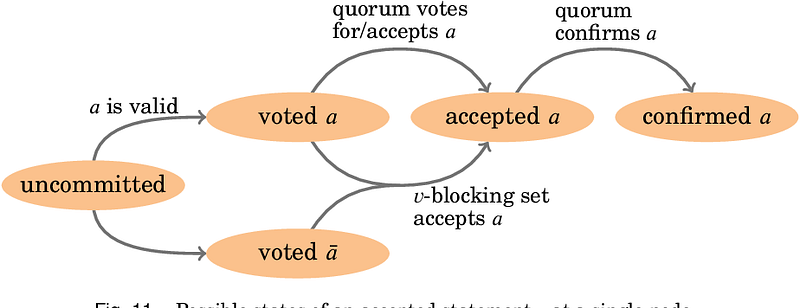A Deep Dive into the Federated Byzantine Agreement Consensus Mechanism
The Federated Byzantine Agreement (FBA) is a consensus mechanism designed to achieve Byzantine Fault Tolerance (BFT) more decentralised and…

The Federated Byzantine Agreement (FBA) is a consensus mechanism designed to achieve Byzantine Fault Tolerance (BFT) more decentralised and flexibly than traditional BFT algorithms. FBA is well-suited for decentralised networks and environments with diverse and changing participants. It allows nodes to select their trusted peers, ensuring that consensus can be reached even in the presence of malicious or faulty nodes.
Here's an overview of how the Federated Byzantine Agreement works:
Quorum Slices and Quorums
FBA relies on the concepts of quorum slices and quorums to achieve consensus. A quorum slice is a subset of nodes within the network that a particular node trusts. Each node defines its quorum slices based on understanding the network and its trusted peers. A quorum is a set of nodes that contains at least one quorum slice for every node within the cluster. In other words, a quorum is a group of nodes that collectively trust each other enough to reach a consensus.
FBA Consensus Algorithm
The FBA consensus algorithm consists of the following steps:
a. Node selection: Each node selects its quorum slices based on trust in other nodes. These quorum slices are locally defined and can vary from node to node.
b. Voting: Nodes vote on statements like transaction validity or ledger version. A node accepts a statement if it believes that a quorum supports the statement.
c. Acceptance and ratification: Nodes propagate accepted statements to other nodes in the network. Once a node sees that a quorum accepts a statement, it considers the statement ratified and acts accordingly.
Advantages of FBA
FBA offers several advantages compared to traditional BFT consensus mechanisms:
a. Decentralisation: FBA allows for open membership, making it more decentralised than traditional BFT mechanisms that rely on a fixed set of validators.
b. Flexibility: Nodes can choose their quorum slices, allowing them to adapt to the changing network conditions and trust relationships.
c. Scalability: FBA's quorum structure can be designed to minimise the communication overhead, making it more scalable than traditional BFT algorithms.
A special implementation of the FBA consensus mechanism is the Stellar Consensus Protocol (SCP), which powers the Stellar network. SCP has proven to be an effective consensus mechanism for the Stellar network, enabling fast and secure transactions while maintaining decentralisation.
Safety and Liveness
FBA ensures both safety and liveness within the network. Safety means that the system never reaches an incorrect or conflicting decision. Liveness ensures that the system will eventually reach a decision. FBA achieves these properties by relying on the quorum structure and iterative voting process, which ensures that the nodes reach an agreement even when some nodes are Byzantine or faulty.
Cascading Failures and Resilience
One of the challenges FBA addresses is the risk of cascading failures. In a decentralised network, a single node's incorrect decision could spread throughout the network, causing a systemic collapse. FBA mitigates this risk by relying on the quorum structure, ensuring that nodes cross-validate each other's decisions before accepting them. This process of checks and balances makes the FBA consensus mechanism highly resilient to cascading failures.
Network Dynamics and Trust
FBA recognises that trust relationships in a decentralised network can change over time. The flexible quorum slice structure allows nodes to trust relationships as the network evolves dynamically. This adaptive nature of FBA enables the consensus mechanism to accommodate diverse, fluctuating, and expanding networks more effectively than traditional BFT mechanisms.
Use Cases
The FBA consensus mechanism is well-suited for various decentralised applications, including financial systems, supply chain networks, and others requiring robust, secure, and scalable consensus. It is particularly suitable for environments where the network participants may not necessarily trust each other yet still need to reach a consensus on transactions and other critical decisions.
Limitations and Challenges
One of the main challenges in the FBA consensus is ensuring that the quorum structure remains balanced and secure, as an improperly designed quorum structure could compromise the safety and liveness properties of the network.
Additionally, FBA may not be as efficient as other consensus mechanisms, as it requires iterative voting and communication among nodes to reach a consensus.
In conclusion, the Federated Byzantine Agreement consensus mechanism offers a robust and flexible solution for achieving Byzantine Fault Tolerance in decentralised networks.
It addresses many of the challenges associated with traditional BFT mechanisms while providing a scalable and adaptable framework that can accommodate decentralised systems' diverse and dynamic nature.
However, it is essential to carefully design the quorum structure and ensure a proper balance between safety and efficiency in the network.
Stay tuned, and happy coding!
Visit my Blog for more articles, news, and software engineering stuff!
Follow me on Medium, LinkedIn, and Twitter.
Check out my most recent book — Application Security: A Quick Reference to the Building Blocks of Secure Software
All the best,
Luis Soares
CTO | Head of Engineering | Blockchain Engineer | Web3 | Cyber Security | Golang & eBPF Enthusiast
#blockchain #stellar #consensus #protocols #smartcontracts #web3 #security #privacy #confidentiality #cryptography #softwareengineering #softwaredevelopment #coding #software



